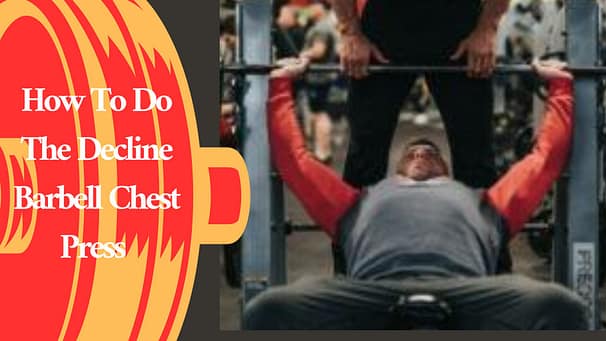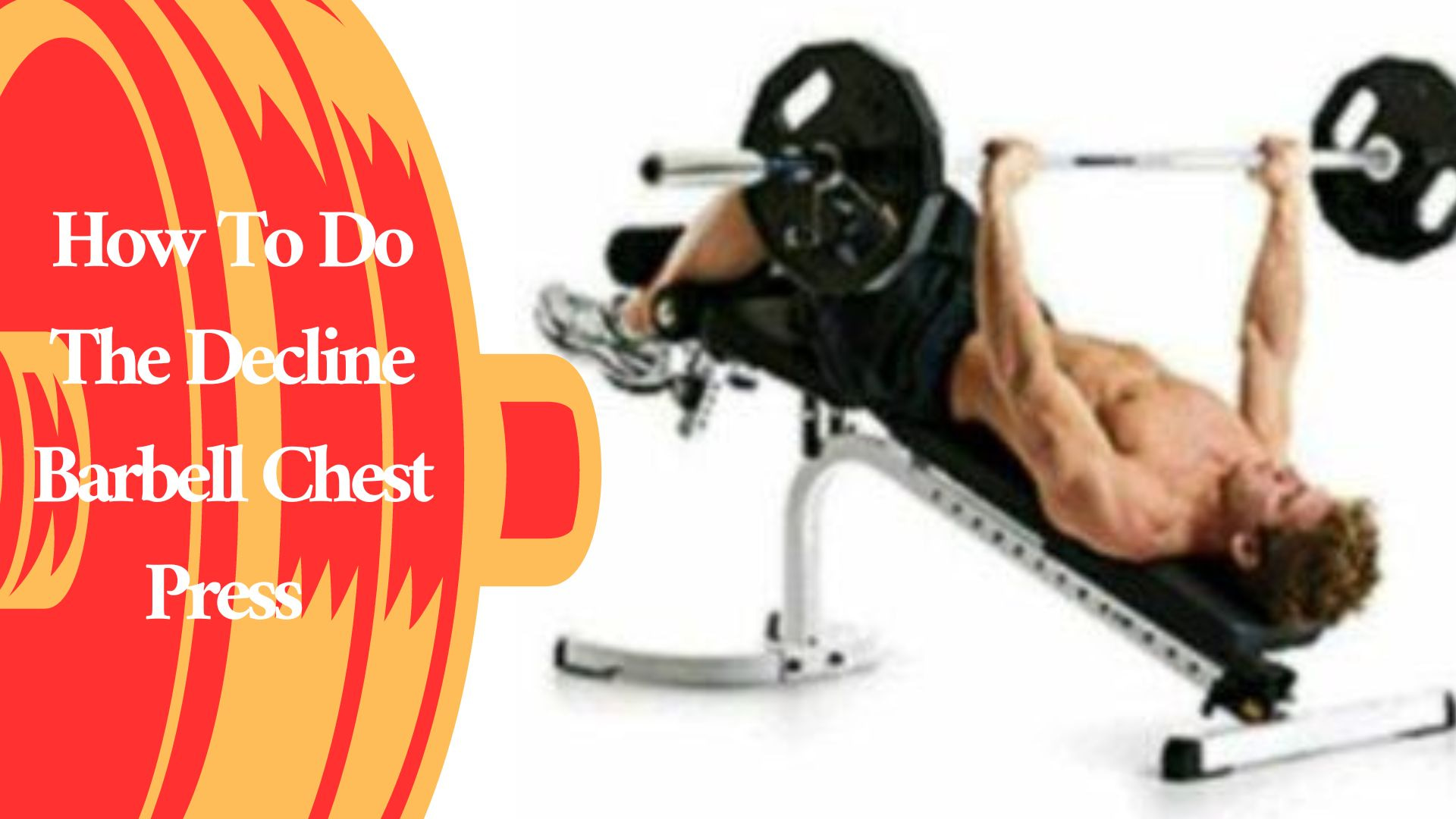The decline barbell chest press is incredibly effective for strengthening the chest and surrounding muscles. When done correctly, this exercise can help you gain muscular endurance, strength, and size in your upper body.
However, if it’s not performed correctly, it can lead to muscle imbalances or even injury. This article will teach you how to do the decline barbell chest press best to maximize its benefits and minimize potential risks.
Ensure you have a good foundation of grip strength to hold the barbell during the exercise effectively. You should also maintain proper form by keeping your feet flat on the floor throughout the training and keeping your back straight and your elbows tucked close to your sides.
List Of Steps To Do The Decline Barbell Chest Press Best
- Set up the decline bench at a 30 to 45-degree angle.
- Load the barbell with the appropriate weight and secure the consequences with collars.
- Lie down on the bench with your feet firmly planted on the ground.
- Grab the barbell with an overhand grip slightly wider than shoulder-width apart.
- Lift the barbell off the rack and hold it above your chest with extended arms.
- Slowly lower the barbell to your lower chest while keeping your elbows tucked in.
-
Set up the decline bench at a 30 to 45-degree angle.
The decline barbell chest press is one of the most effective exercises for targeting the lower pectoral muscles. Setting up the decline bench at a 30-45 degree angle is essential to get the most out of this exercise.
To understand why it’s helpful to look at how different angles affect muscle engagement and resistance levels.
When done correctly, setting up the decline bench at a 30-45 degree angle helps maximize your efforts and yields better results.
More stress is placed on your shoulders at a steeper angle than at a shallower angle, making it easier for you to perform more reps with heavier weights.
At more external angles, more emphasis is put on your triceps and core muscles, which may help build strength faster due to increased instability during movement.
-
Load the barbell with the appropriate weight and secure the consequences with collars.
When performing the decline barbell chest press, ensure you have loaded the barbell with an appropriate amount of weight. It will depend on your experience level and current strength levels; beginners should start with light weights, while more experienced lifters may be able to handle heavier weights.
-
Lie down on the bench with your feet firmly planted on the ground.
The decline barbell chest press is a classic exercise for building strength and muscle mass in the chest, shoulders, and arms.
It is a form of resistance training that involves pushing the weight away from your body with the help of a barbell. When done correctly, the decline barbell chest press can effectively target your muscles while reducing the risk of injury. Those looking to get more out of their chest workout should consider adding the declined barbell chest press into their routine.

When performing this exercise, it is essential to ensure that you are correctly positioned on the bench before beginning.
Lie on the bench with your feet firmly planted on the ground this will provide stability and help keep you in proper form throughout the movement. While holding onto either side of the barbell, lower it towards your mid-chest before pushing it up again.
-
Grab the barbell with an overhand grip slightly wider than shoulder-width apart.
If you want to get the most out of your chest workouts, the decline barbell chest press is a step in the right direction. But before you start lifting, specific actions for maximum efficiency and safety. To do the decline barbell chest press correctly, you must grab the barbell with an overhand grip slightly wider than shoulder-width apart.
It will help ensure that your arms move directly up and down when pressing the weight, maximizing muscle building while reducing strain on your rotator cuffs and other joints.
Moreover, an overhand grip on the barbell allows for a more excellent range of motion during such exercises. The wider grip also decreases stress on your elbows by enabling them to bend more easily while taking some pressure off of your wrists as well.
-
Lift the barbell off the rack and hold it above your chest with extended arms.
To do the decline barbell chest press, lift it off the rack and hold it above your chest with your arms fully extended. This position allows you to perform the exercise with more excellent resistance than lying flat on a bench.
This exercise will work your pectoral muscles and triceps in a single motion when done correctly.
Additionally, because you are lifting more weight when standing up, it can help increase muscle definition and size faster than if done lying down.
Furthermore, engaging in this exercise can also improve posture and reduce the risk of injury due to its natural range of motion.
-
Slowly lower the barbell to your lower chest while keeping your elbows tucked in.
Declining barbell chest press is among the most popular exercises when exercising the chest. This exercise can be done with various equipment and weights, but using a barbell will help you get the best results.
To do the decline barbell chest press correctly, slowly lower the barbell down to your lower chest while keeping your elbows tucked in throughout the movement.
This technique is essential, as it helps you focus on contracting your muscles during this exercise. Concentrating on this step maximizes your workout for a more effective decline barbell chest press.
Additionally, it ensures that you are working out safely with proper form and posture and that there’s no strain placed on other parts of your body, such as your shoulders or back.
Quick guide
You will need a spotter. You need someone to assist you before the exercise.
Set the incline bench to 45 degree recommended angle
Don’t exaggerate or overweight yourself, load lightly when you wanna get started.
Don’t let the weight stray off from your hands, hold it tight
Position yourself very well on the decline bench. Don’t move your legs around.
Use an underhand grip to grab the straight bar for better performance.
So, bend your arms slowly, while still holding the bar toward the ceiling.
Lower down the bar straight down, until it touches the lower part of your chest.
Hold that position briefly for a second, before you press back up, the
reason for this is that, you want to make sure that the lower chest muscles are fully contrasted.
Then extend your elbows and press back to the starting position.
You can then repeat the exact process again to prior to your rep.
I go for 8 to 12 reps per set. If you like, you can do more. It’s all up to you. Just don’t exaggerate upon it.
Safety measures to take into consecrations during declining barbell chest press performance.
Always remember
Always remember that you are in a decline position, so you will need a spotter or someone that can assist you up during the execution.
This is very important because you never know you may have a difficult time sometimes pushing the weight back up again. That can happen to anyone.
So, ask for help. You can ask your trainer or one of your gym friends to help you out.
Concentrate and focus
Don,t rush yourself on this exercise, move slowly for better performance.
Concentrate and focus on the target lower part of your chest. Don’t let weight stray off or fall off from your hands.
Don’t exaggerate yourself
Don’t overweight your self load the weight that your power can be able to control throughout the exercise.
you are in a decline position, you may want to start with the lighter weight first then add up to it later along the line.
Remember that you have to hold the weight briefly at the down
position for a second or 2 to contrast your lower chest muscles fully before you now move it back up to the beginning position.
So, the downward movement should be slightly slower than the up move movement.
Don’t create any bad momentum for yourself
Take care, don’t let your elbow lock down on the Downside, don’t bounce the weight down to your chest that might hot you.
Do not create any momentum that can jeopardize the perfect performance throughout.
Let your legs be still, don’t move your head, don’t raise your neck, and the rest part of your body, move only your hands throughout.
Don’t let the weight control you
You should be the one that controls the weight throughout. Don’t letthe weight controls you.
That is why you don’t have to overweight yourself on this one.
Make sure that you have an attentive spotter whenever you want to train with more weight.
what are the benefits of doing decline barbell chest press?
It helps to target, train, and strengthen the lower chest muscles
It is one of the best chest training exercise for the lower pectoralis
Doing decline barbell chest press regularly with a good diet taken into consideration will make physically fit, transform your body, and make you strong. It will also boost more power to your chest.
Decline barbell chest press will help to build definitions of your chest.
The decline barbell chest press is great exercise good to add more size and boost more strength to it.
What is the difference between Decline Barbell Chest Press and the decline dumbbells chest press?
You would be using dumbbells and a decline bench for the decline
dumbbells chest press while on the decline barbell chest press, you need a straight barbell and a decline bench.
The decline dumbbells chest the bench is regulated to 15 to 30
degrees while decline barbell chest press bench is regulated 45 degrees.
Decline Barbell Chest Press Exercise Overview
Exercise type: Strength
Target zone: Lower chest
Equipment needed: Barbel, decline bench
Final Thoughts
In conclusion, the decline barbell chest press is an effective exercise for developing the chest muscles. Maintaining proper form throughout this exercise and paying close attention to your body’s cues is essential to ensure you are getting the most out of it. Ensuring you have a spotter on hand is also an important safety measure. Additionally, using a weight that will challenge you but not overwhelm you is beneficial.
